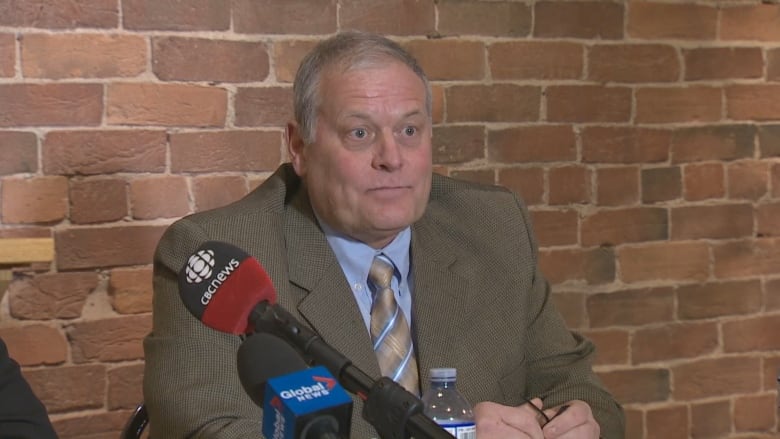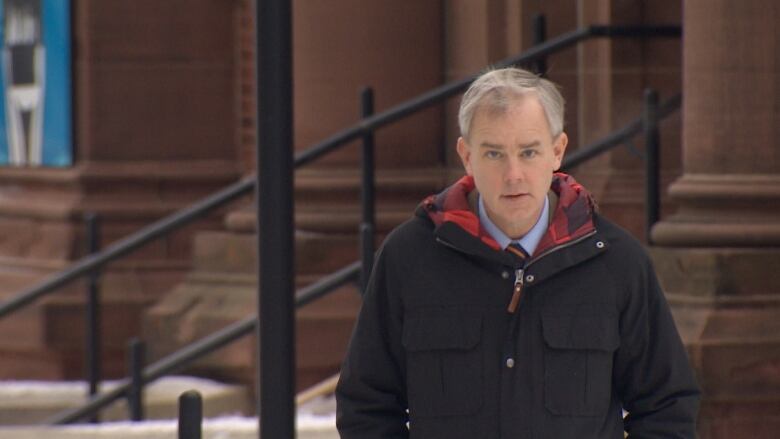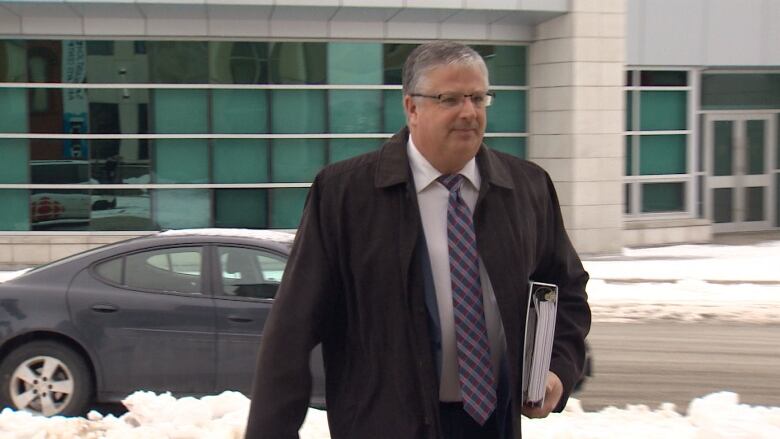Ex-deputy chief sat in bloody crime scene, officer testifies at Oland murder retrial
Dennis Oland is being retried for 2nd-degree murder in 2011 bludgeoning death of father Richard Oland

The former deputy chief of the Saint John Police Force sat on a piece of office furniture in the bloody Richard Oland homicide scene before forensic testingwas complete, an officer testified Tuesday at Dennis Oland'smurder retrial.
Sgt. Greg Oram, testifying for the first time in connection with the 2011 case, toldthe court he was in the victim's office with then-inspector Glen McCloskey at the time on the morning of July 7shortly after the multimillionaire's body had been discovered.
Oramsaid he was crouched about two or three feet away from the body, observing the significant injuries to thehead, when McCloskeycommented he hoped that it was a suicide and they would find a gun underneath the body because it "would be easier."
That's when he looked up and saw McCloskey"half-sitting" on a desk, or table or credenza, with one foot on the floor and the other leg dangling, he said.
They both subsequently wandered through much of the office before the head of the forensicsunit returned and told them to get out, said Oram.
Neither McCloskey, who was the head of the criminal investigations division, nor Oram, who was a constable with the major crime unit, were wearing any protective gear, the courtroom heard.
Oland's defence team has accused the Crown of purposely "hiding" Oramby not calling him to testify at the preliminary inquiry in 2014 or at the first trial in 2015, which ended with a jury finding Olandguilty of second-degree murder in his father's bludgeoning death.

Oland, 50, is being retried after the New Brunswick Court of Appeal overturned his conviction in 2016, citing an error in the trial judge's instructions to the jury.
Oramtestified under cross-examination by defence lawyer Michael Lacy that he understood he was going to testify at the preliminary inquiry and even had a meeting with one of the Crown prosecutors to prepare, but he was never called. No explanation was ever given, he said.
On Monday, retired Staff Sgt. Mike King testified again about his allegation that McCloskeyhad encouraged him not to reveal McCloskey had entered the bloody crime scene.
King first made the allegation during Oland'sfirst trial. McCloskeydenied the allegation, telling the court he had entered the office twice that dayfirst under the supervision of the head offorensicsto observe the bodyand then again with Oram, out of "curiosity."
McCloskey said he was "embarrassed," admitting that he went farther into the crime scene than directed by the head of forensicsand without any protective gear on.
McCloskey, who retired lastApril,is expected to testify at the retrial.

On Tuesday, Crown prosecutor P.J. Veniot asked Oramto tell the court where he went in the office and where he allegedly saw McCloskey sitting. Oland's defence lawyer argued Oram'sdescriptions of "over here" and "over there" were too confusing. Justice Terrence Morrison agreed itwas unclear.
"At this point I'm lost," the judge said. "Remember, I'm the one that has to understand this evidence."
Veniot asked Oramto mark the locations on a diagram of the office. Oramindicated he was initially crouched on the right side of the body and McCloskeywas on a table or desk to his left.
Veniotlater showed Oramphotographs of the office in an attempt to further clarify their exact locations. Oram told the court he had never seen the photographs before and altered where he saidMcCloskeywas sitting. Hewas still to his left, but on a credenza and farther from the body, behind an office divider.
Both locations were on the opposite side of the office where the head of forensics had previously allowed McCloskeyto enter under his supervision, and where McCloskeyhad testified to going.

Oland'slawyer challenged Oram'stestimony during cross-examination, noting he had said he was "certain" both times about McCloskey'slocation while seated. Oraminsisted that after seeing the photos he was now certain.
Lacy then had Orammark onthe office diagram his own routes of travel during the estimatedfive to 10 minutes he said they spent in the office. The lines covered almost the entire length of the office, both sides of a table down the centre of the office and both sides of the desk the body was under.
Lacy suggested Oram"traipsed all over." Oramreplied he "went through a significant amount, but not the entire office."
Oram,who has been with the force for about 30 years, said he was under the impression forensic testing was complete and followed McCloskey's lead.
He also said he made a "conscious effort" not to disturb any evidence. But Lacy argued he wouldn't know if he had disturbedany trace evidence, invisible to the nakedeye. Oram agreed.

Earlier in the day, the court heard continued testimony from acting Insp. David Brooker, who was the sergeant in charge of the major crime unit in 2011.
Brookersaid hewent to the crime scene with McCloskeythat day. Hetestified the head of forensics, Sgt. Mark Smith, took them into the office before the body had been removed. He said he didn't touch anything and he didn't see McCloskey touch anything either, adding they were only in the officefor "30 seconds or so."
Brooker said it still wasn't clear at the time whether it was a homicide or suicide, but "regardless, we shouldn't have been in that area."
Oland is the last person known to have seen hisfather alive when he visited him at his office on the evening of July 6, 2011.
The body of the 69-year-old was found in the office the next morning, face down in a pool of blood. He had suffered 45 sharp- and blunt-force injuries to his head, neck and hands.
- On mobile? Follow our live blog of the Oland trial












_(720p).jpg)


 OFFICIAL HD MUSIC VIDEO.jpg)
.jpg)



























































































